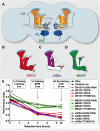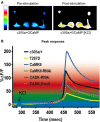CASK and CaMKII function in Drosophila memory
- PMID: 25009461
- PMCID: PMC4070058
- DOI: 10.3389/fnins.2014.00178
CASK and CaMKII function in Drosophila memory
Abstract
Calcium (Ca(2+)) and Calmodulin (CaM)-dependent serine/threonine kinase II (CaMKII) plays a central role in synaptic plasticity and memory due to its ability to phosphorylate itself and regulate its own kinase activity. Autophosphorylation at threonine 287 (T287) switches CaMKII to a Ca(2+) independent and constitutively active state replicated by overexpression of a phosphomimetic CaMKII-T287D transgene or blocked by expression of a T287A transgene. A second pair of sites, T306 T307 in the CaM binding region once autophosphorylated, prevents CaM binding and inactivates the kinase during synaptic plasticity and memory, and can be blocked by a TT306/7AA transgene. Recently the synaptic scaffolding molecule called CASK (Ca(2+)/CaM-associated serine kinase) has been shown to control both sets of CaMKII autophosphorylation events during neuronal growth, Ca(2+) signaling and memory in Drosophila. Deletion of either full length CASK or just its CaMK-like and L27 domains removed middle-term memory (MTM) and long-term memory (LTM), with CASK function in the α'/ß' mushroom body neurons being required for memory. In a similar manner directly changing the levels of CaMKII autophosphorylation (T287D, T287A, or TT306/7AA) in the α'/ß' neurons also removed MTM and LTM. In the CASK null mutant expression of either the Drosophila or human CASK transgene in the α'/ß' neurons was found to completely rescue memory, confirming that CASK signaling in α'/β' neurons is necessary and sufficient for Drosophila memory formation and that the neuronal function of CASK is conserved between Drosophila and human. Expression of human CASK in Drosophila also rescued the effect of CASK deletion on the activity state of CaMKII, suggesting that human CASK may also regulate CaMKII autophosphorylation. Mutations in human CASK have recently been shown to result in intellectual disability and neurological defects suggesting a role in plasticity and learning possibly via regulation of CaMKII autophosphorylation.
Keywords: CASK; CaMKII; Drosophila; autophosphorylation; calcium imaging; disease model; memory; mushroom body.
Figures



Similar articles
-
CASK and CaMKII function in the mushroom body α'/β' neurons during Drosophila memory formation.Front Neural Circuits. 2013 Mar 27;7:52. doi: 10.3389/fncir.2013.00052. eCollection 2013. Front Neural Circuits. 2013. PMID: 23543616 Free PMC article.
-
CASK regulates CaMKII autophosphorylation in neuronal growth, calcium signaling, and learning.Front Mol Neurosci. 2013 Sep 11;6:27. doi: 10.3389/fnmol.2013.00027. eCollection 2013. Front Mol Neurosci. 2013. PMID: 24062638 Free PMC article.
-
Activity-dependent gating of CaMKII autonomous activity by Drosophila CASK.Neuron. 2006 Aug 3;51(3):327-37. doi: 10.1016/j.neuron.2006.06.020. Neuron. 2006. PMID: 16880127
-
Physiological and Pathological Roles of CaMKII-PP1 Signaling in the Brain.Int J Mol Sci. 2017 Dec 22;19(1):20. doi: 10.3390/ijms19010020. Int J Mol Sci. 2017. PMID: 29271887 Free PMC article. Review.
-
Regulation and role of brain calcium/calmodulin-dependent protein kinase II.Neurochem Int. 1992 Dec;21(4):469-97. doi: 10.1016/0197-0186(92)90080-b. Neurochem Int. 1992. PMID: 1338943 Review.
Cited by
-
Low-nutrient diet in Drosophila larvae stage causes enhancement in dopamine modulation in adult brain due epigenetic imprinting.Open Biol. 2023 May;13(5):230049. doi: 10.1098/rsob.230049. Epub 2023 May 10. Open Biol. 2023. PMID: 37161288 Free PMC article.
-
Physicochemical Principles of Adhesion Mechanisms in the Brain.Int J Mol Sci. 2023 Mar 7;24(6):5070. doi: 10.3390/ijms24065070. Int J Mol Sci. 2023. PMID: 36982145 Free PMC article. Review.
-
N-Butylphthalide Improves Cognitive Function in Rats after Carbon Monoxide Poisoning.Front Pharmacol. 2017 Feb 9;8:64. doi: 10.3389/fphar.2017.00064. eCollection 2017. Front Pharmacol. 2017. PMID: 28232802 Free PMC article.
-
FMRFa receptor stimulated Ca2+ signals alter the activity of flight modulating central dopaminergic neurons in Drosophila melanogaster.PLoS Genet. 2018 Aug 15;14(8):e1007459. doi: 10.1371/journal.pgen.1007459. eCollection 2018 Aug. PLoS Genet. 2018. PMID: 30110323 Free PMC article.
-
The biological functions and pathological mechanisms of CASK in various diseases.Heliyon. 2024 Mar 29;10(8):e28863. doi: 10.1016/j.heliyon.2024.e28863. eCollection 2024 Apr 30. Heliyon. 2024. PMID: 38638974 Free PMC article. Review.
References
Publication types
Grants and funding
LinkOut - more resources
Full Text Sources
Other Literature Sources
Molecular Biology Databases
Miscellaneous

